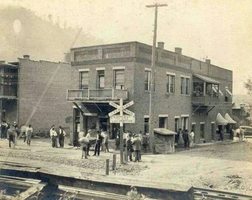 | Back to e-WV
| Back to e-WV
 The West Virginia Encyclopedia
The West Virginia Encyclopedia
 | Back to e-WV
| Back to e-WV
 The West Virginia Encyclopedia
The West Virginia Encyclopedia

In January 1920, the United Mine Workers of America launched a major campaign to organize the non-union coalfields of southern West Virginia. Along the West Virginia-Kentucky line, some 3,000 miners responded by joining the union and, under coal company policies forbidding employment of union miners, were discharged from their jobs. Hundreds also were forced to vacate their company-owned homes, and many who refused were forcibly evicted by hated Baldwin-Felts detectives.
On May 19, 1920, 13 Baldwin-Felts detectives, including Al and Lee Felts, brothers of one of the agency founders, arrived in the Mingo County town of Matewan on the Tug Fork to evict striking miners and their families from company houses. The detectives, under an intermittent drizzle, forced several families, including women and children, from their homes at gunpoint and dumped their belongings out on the road. Word of the evictions enraged area miners, who began arming themselves.
Matewan’s police chief, Sid Hatfield, 27, a strike supporter, tried to stop the evictions as being unauthorized by law. At 4:00 p.m., as the detectives prepared to leave, Hatfield, accompanied by Matewan Mayor Cabell C. Testerman and a host of angry miners, confronted Al Felts near the Matewan railroad station and tried to arrest him. Felts, in turn, tried to arrest Hatfield. As the men argued, shooting started.
Hatfield admitted he fired but said Al Felts shot first. A number of the miners and several detectives joined in. When it ended a minute or two later, ten people—seven Baldwin-Felts detectives (including both Felts brothers), two miners, and Mayor Testerman—had been fatally shot.
Hatfield and 17 strikers were tried for murder in early 1921 and were all acquitted; such was the hatred of the detective agency. The Matewan Massacre is often cited as the opening of the West Virginia Mine War of 1920–21, which escalated into an armed conflict involving thousands after Hatfield’s murder at Welch later in 1921.
On February 18, 1997, the Matewan Historic District was designated a National Historic Landmark. In 2015, the West Virginia Mine Wars Museum opened in Matewan to tell the story of and display artifacts from this turbulent period in state and national history.
e-WV presents West Virginia Public Broadcasting on the Matewan Massacre
Written by Lon Savage
Savage, Lon. Thunder in the Mountains. Pittsburgh: University of Pittsburgh Press, 1990.
Lee, Howard B. Bloodletting in Appalachia. Morgantown: West Virginia University, 1969.
U.S. Senate. West Virginia Coal Fields. Hearings before the Committee on Education & Labor. 67th Congress, first session, 2 vols. United States Government Printing Office. Washington.